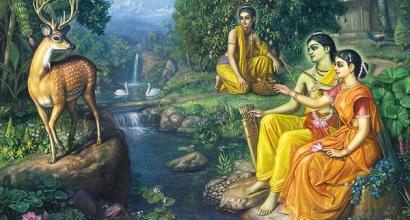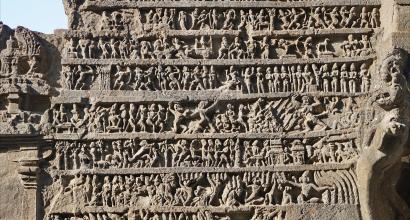The following is a summary of the story of the play Mudrārākṣasa –
[Upon the elimination of the lineage of the Nandas, Amātya-rākṣasa joins hands with Malayaketu and attempts to besiege Candra-gupta’s kingdom. Cāṇakya, however, wanted to capture Amātya-rākṣasa and make him Candra-gupta’s prime minister. Rākṣasa, on the other hand, would not agree to change his loyalty to anyone else even if he found that there was some blood of the Nandas still surviving. Therefore, Cāṇakya gets Sarvārtha-siddhi, who was the last surviving relative of the Nandas, killed even as the latter was in his tapovana. His spies reported to him the plans and activities of Rākṣasa.]
Nipuṇaka, one of Cāṇakya’s spies, chances upon Rākṣasa’s signet ring, thanks to the favourable turn of fate. Upon receiving it, Cāṇakya gets Śakaṭadāsa, who was originally Rākṣasa’s scribe, to write a letter without indicating the addressee; he seals it with Rākṣasa’s signet ring and hands it over to Siddhārthaka. He creates a ploy where he pretends to subject Śakaṭadāsa to execution and Siddhārthaka acts as if he has rescued the latter from the crooked plans of Cāṇakya; Siddhārthaka escorts Śakaṭadāsa to Rākṣasa’s ‘safety’. Cāṇakya puts Canadana-dāsa, who had originally possessed Rākṣasa’s signet ring, behind bars. He gained the confidence of Bhadra-bhaṭa and others and made them pretend as though they were taking refuge in Rākṣasa, distressed with Cāṇakya.
All the strategies that Rākṣasa strung together to eliminate Candra-gupta went futile, thanks to Cāṇakya’s genius and also the quirks of fate; they, in fact, worked against him. Rākṣasa had appointed a viṣa-kanyā to kill Candra-gupta, but instead, Parvata-rāja lost his life because of her; the news that the lady was appointed by Rākṣasa spread through the kingdom like wildfire and this brought him ill-fame. Jīva-siddhi, was accused of bringing her and was banished from the kingdom. (He was, in fact, Cāṇakya’s friend named Indu-śarmā; he was pretending to be Rākṣasa’s ally.) Parvataka’s younger brother Vairocaka, Dāru-varmā – the carpenter, Barbaraka – the mahut, Abhaya-datta – the physician, and Pramodaka, who was in the sleeping chambers, are killed one after the other. By this time, Siddhārthaka brings Śakaṭadāsa to ‘safety’; Rākṣasa, who is happy for his friend, gifts Siddhārthaka with his ornaments as a sign of gratitude for rescuing Śakaṭadāsa; Siddhārthaka requests Rākṣasa to hold on to the casket of ornaments and marks the seal of the signet ring upon it; Rākṣasa hands it over to Śakaṭadāsa and requests Siddhārthaka to stay back with him. Cāṇakya forges alliance with a few brāhmaṇas; they disguise themselves as merchants, approach Rākṣasa and sell him the jewels that belonged to Parvata-rāja.
Cāṇakya and Candra-gupta pretend to fall apart under a silly pretext; a person by the name Stana-kalaśa observes this and sides with Candra-gupta; he praises the king eloquently and Cāṇakya immediately realises that he is Rākṣasa’s spy; he, therefore, gives the impression that his fight with Candra-gupta has only grown more intense. Candra-gupta too pretends to appreciate and glorify Rākṣasa and demeans Cāṇakya; to this, Cāṇakya pretends to be annoyed and publicly declares that he would give up his post as the minister.
Rākṣasa hears everything that had transpired in Kusuma-pura. Malayaketu and Bhāgurāyaṇa arrive to meet Rākṣasa. Bhāgurāyaṇa makes it a point to misinterpret the words spoken by Rākṣasa, Bhadra-bhaṭa, and others; Malayaketu starts believing that Rākṣasa is devoted to Candra-gupta. On the other hand, Rākṣasa who thinks that Candra-gupta and Cāṇakya have actually parted ways, prepares to attack their kingdom.
Bhāgurāyaṇa comes to Jīvasiddhi and speaks to him in a loud voice such that Malayektu hears it – he says that Rākṣasa instigated the viṣa-kanyā to kill Parvata-rāja. Siddhārthaka who was carrying with him the letter that was scribed by Śakaṭadāsa and the casket of ornaments that bore Rākṣasa’s seal, pretends to get caught; he tells Malayaketu that Rākṣasa planned every deed; he adds that Rākṣasa along with Citra-varmā and other lesser kings were waiting to seek the goodwill of Candra-gupta. Malayaketu is shocked and disheartened. He corners Rākṣasa with his questions and the former minister of the Nandas is unable to prove that all the accusations are false. Malayektu shoos away Rākṣasa and gets Citra-varmā and other kings killed.
The other kings abandon Malayaketu and return to their kingdoms. Bhadra-bhaṭa and others capture him. Rākṣasa who is confused about the next course of action, arrives at the garden in Pāṭalīputra; there, he finds Udumbara who is about to commit suicide by hanging himself. Rākṣasa learns from him that Candana-dāsa is about to be executed and rushes to the crematorium.
Rākṣasa wishes to sacrifice his life on behalf of his friend – he requests to be executed and wants Candana-dāsa to be relieved; Candra-gupta and Cāṇakya request him to accept the post of prime minister. Malayaketu gets back his father’s kingdom; Cāṇakya finally ties his long śikhā.
To be continued ...
The current series of articles is an enlarged adaption of Prof. A. R. Krishnasastri's Kannada treatise Saṃskṛta-nāṭaka. They are presented along with additional information and footnotes by Arjun Bharadwaj.














































